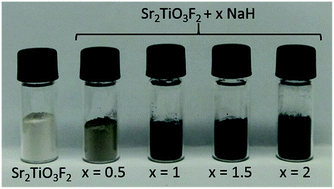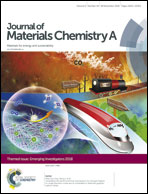Developing intercalation based anode materials for fluoride-ion batteries: topochemical reduction of Sr2TiO3F2via a hydride based defluorination process†
Abstract
Within this study, we demonstrate a newly developed reductive topochemical defluorination method which allows for a selective extraction/substitution of fluoride ions out of transition metal oxyfluorides using NaH as the reducing agent at temperatures as low as 300 °C, enabling the preparation and investigation of anode materials for fluoride-ion batteries in the charged state. A sequence of topochemical reactions, first substitutive fluorination of the K2NiF4 type precursor oxide Sr2TiO4 to Sr2TiO3F2 followed by the reductive defluorination/hydride-fluoride-substitution of Sr2TiO3F2, leads to the formation of compounds with approximate compositions of Sr2TiO3FH0.48 and Sr2TiO3H1.48. The evolution of the unit cell volumes upon extraction/substitution of fluoride ions has been monitored by an X-ray diffraction study. Strong structural changes were observed during the reaction, expressed by a decrease of the c-axis from ∼15.5 Å in Sr2TiO3F2 to ∼13.0 Å in Sr2TiO3FH0.48 and ∼12.7 Å in Sr2TiO3H1.48, with additional symmetry lowering for Sr2TiO3FH0.48, and confirmed by neutron powder diffraction. Changes of the Ti oxidation states and coordination environment were examined and confirmed by means of X-ray absorption spectroscopy, electron paramagnetic resonance and magnetic measurements. Furthermore, we found that the surface chemistry of such compounds differs significantly from the bulk properties by means of an X-ray photoelectron spectroscopy study, showing that surface compositions of Sr2TiO3F and Sr2TiO3 with Ti3+ and Ti2+ species can be obtained on the reaction, respectively. We further highlight that a ‘direct’ reduction of the oxide precursor Sr2TiO4 to Sr2TiO3 is not possible using the same method. Therefore, the two-step modification of Sr2TiO4 allows for the preparation of compounds with low oxidation states at the lowest temperatures used so far for hydride based reductions of titanium containing oxides (300 °C compared to ∼600 °C used previously). The observed differences in the reactivity of oxyfluorides compared to oxides are well supported by DFT based calculations of formation energies. They show that the formation of NaF is a strong driving force, resulting in exergonic reductions/hydride-fluoride substitution reactions as compared to the endergonic formation of Na2O for pure oxide compounds.

- This article is part of the themed collection: Journal of Materials Chemistry A Emerging Investigators


 Please wait while we load your content...
Please wait while we load your content...